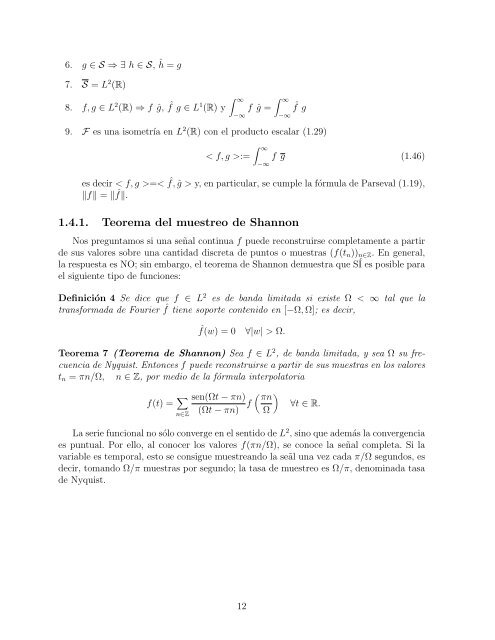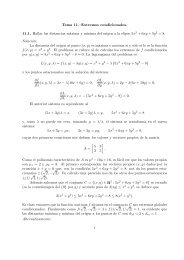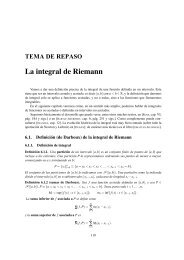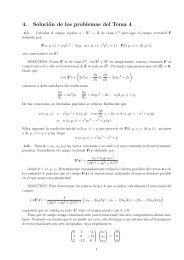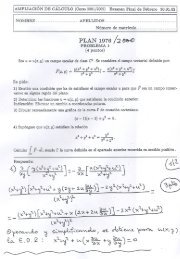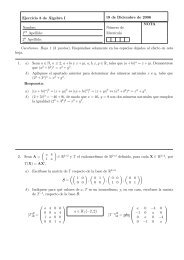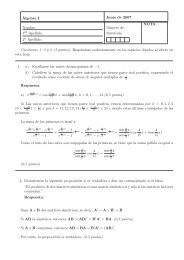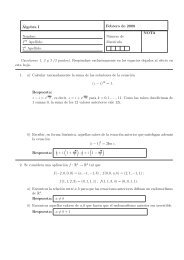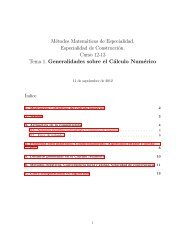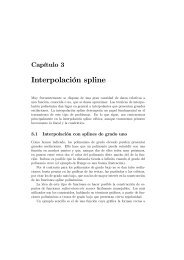La transformada wavelet: una introducción - Departamento de ...
La transformada wavelet: una introducción - Departamento de ...
La transformada wavelet: una introducción - Departamento de ...
You also want an ePaper? Increase the reach of your titles
YUMPU automatically turns print PDFs into web optimized ePapers that Google loves.
6. g ∈ S ⇒ ∃ h ∈ S, ˆ h = g<br />
7. S = L 2 (R)<br />
8. f, g ∈ L2 (R) ⇒ f ˆg, ˆ f g ∈ L1 ∞<br />
(R) y<br />
−∞<br />
∞<br />
f ˆg =<br />
9. F es <strong>una</strong> isometría en L 2 (R) con el producto escalar (1.29)<br />
−∞<br />
−∞<br />
ˆf g<br />
∞<br />
< f, g >:= f g (1.46)<br />
es <strong>de</strong>cir < f, g >=< ˆ f, ˆg > y, en particular, se cumple la fórmula <strong>de</strong> Parseval (1.19),<br />
f = ˆ f.<br />
1.4.1. Teorema <strong>de</strong>l muestreo <strong>de</strong> Shannon<br />
Nos preguntamos si <strong>una</strong> señal continua f pue<strong>de</strong> reconstruirse completamente a partir<br />
<strong>de</strong> sus valores sobre <strong>una</strong> cantidad discreta <strong>de</strong> puntos o muestras (f(tn))n∈Z. En general,<br />
la respuesta es NO; sin embargo, el teorema <strong>de</strong> Shannon <strong>de</strong>muestra que SÍ es posible para<br />
el siguiente tipo <strong>de</strong> funciones:<br />
Definición 4 Se dice que f ∈ L 2 es <strong>de</strong> banda limitada si existe Ω < ∞ tal que la<br />
<strong>transformada</strong> <strong>de</strong> Fourier ˆ f tiene soporte contenido en [−Ω, Ω]; es <strong>de</strong>cir,<br />
ˆf(w) = 0 ∀|w| > Ω.<br />
Teorema 7 (Teorema <strong>de</strong> Shannon) Sea f ∈ L 2 , <strong>de</strong> banda limitada, y sea Ω su frecuencia<br />
<strong>de</strong> Nyquist. Entonces f pue<strong>de</strong> reconstruirse a partir <strong>de</strong> sus muestras en los valores<br />
tn = πn/Ω, n ∈ Z, por medio <strong>de</strong> la fórmula interpolatoria<br />
f(t) = <br />
n∈Z<br />
sen(Ωt − πn)<br />
(Ωt − πn) f<br />
<br />
πn<br />
Ω<br />
∀t ∈ R.<br />
<strong>La</strong> serie funcional no sólo converge en el sentido <strong>de</strong> L 2 , sino que a<strong>de</strong>más la convergencia<br />
es puntual. Por ello, al conocer los valores f(πn/Ω), se conoce la señal completa. Si la<br />
variable es temporal, esto se consigue muestreando la seãl <strong>una</strong> vez cada π/Ω segundos, es<br />
<strong>de</strong>cir, tomando Ω/π muestras por segundo; la tasa <strong>de</strong> muestreo es Ω/π, <strong>de</strong>nominada tasa<br />
<strong>de</strong> Nyquist.<br />
12


